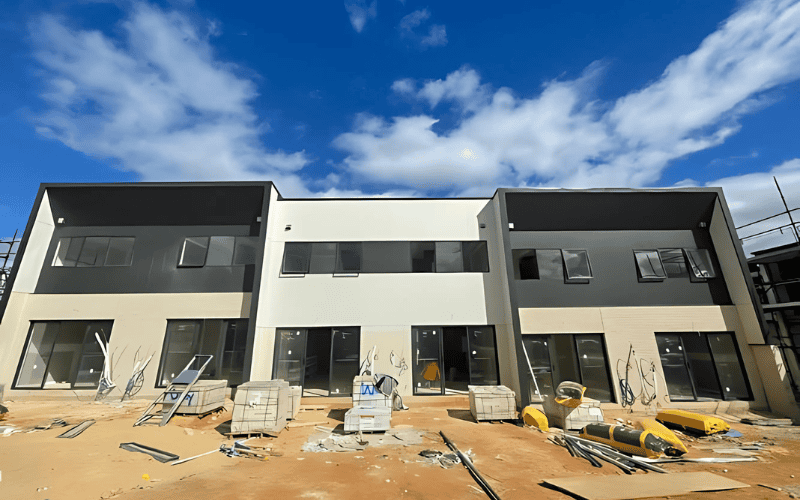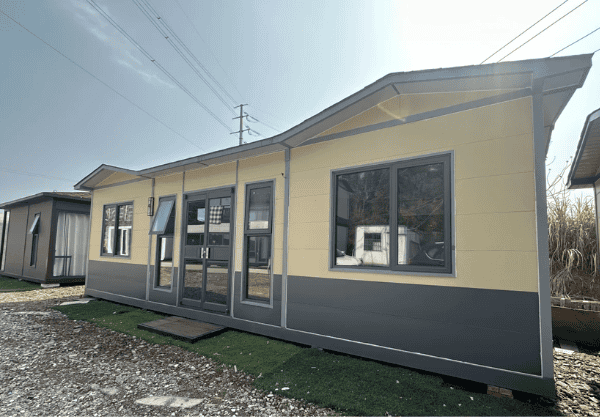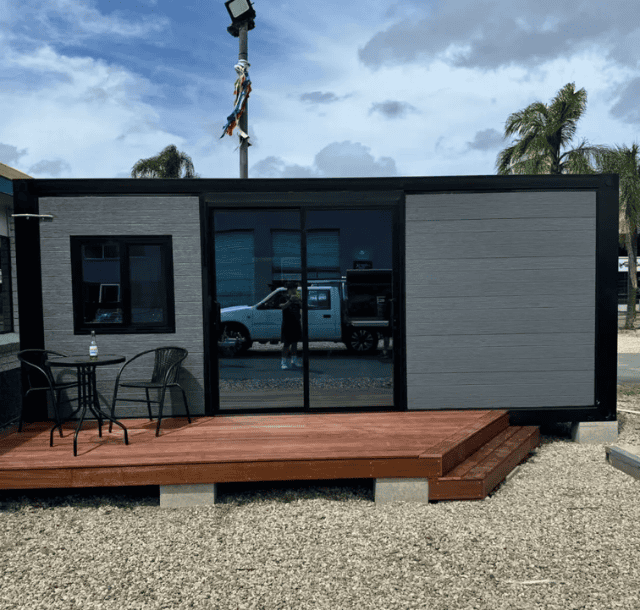If you’re considering a modular home, you probably want an answer right away—and the good news is, modular homes can typically be built in 4 to 7 months, much faster than traditional homes that can take up to a year or more.
But there’s more to the story. While speed is a major advantage, there are several factors that can affect the timeline, from site preparation to custom designs. In this article, we’ll break down the typical build time, explain what could cause delays, and show you why choosing a modular home might be the smartest decision you can make for your next project.
What Is a Modular Home?
A modular home is a modern, permanent structure made of factory-built sections called modules, which are transported to the site and assembled on a foundation.
Unlike mobile homes, modular homes are not temporary; they meet the same building codes as traditional houses and often offer better quality control due to the factory setting. Modular homes are an excellent option if you seek an efficient, customizable, and dependable residence.
How long does it take to build a modular home?
Typically, modular homes take between 16 and 31 weeks (4-7 months), which is much faster than traditional homes. This faster construction time is one of the main reasons many homebuyers choose modular construction over traditional site-built homes.
Here we briefly outline the general timeline for building modular homes for you:
1. Consultation and Design (1-2 Weeks)
In this phase, we’ll work closely with you to discuss your design preferences and make sure your ideas are reflected in the final layout. You’ll choose materials, styles, and layouts that fit your vision. At the same time, we’ll inspect your site to ensure the foundation preparation can begin smoothly.
2. Permitting and Site Preparation (3-10 Weeks)
This stage involves obtaining the necessary local permits and preparing your site for construction. This may entail clearing the land, leveling the site, and establishing the foundation. The length of this phase depends on the approval speed of local authorities and the complexity of your site, usually taking anywhere from 3 to 10 weeks.
3. Factory Construction (12-16 Weeks)
While your site is being prepared, we’ll begin building the modules in a controlled factory environment. This is where the bulk of the construction happens, and because it’s indoors, weather delays aren’t an issue. Factory construction Typically takes 12 to 16 weeks, and we’ll ensure everything is built to your design specifications with strict quality control.
4. Final Installation and Touch-ups (2-4 Weeks)
Once the modules are complete and transported to your site, we’ll start assembling them and connecting the necessary utilities like water and electricity. This final phase typically takes 2 to 4 weeks, during which we’ll also handle any finishing touches, ensuring your home is ready for you to move in.
Related Reading: Modular home building process
Modular Homes vs Traditional Homes: How Much Faster Is Modular Construction?
Traditional home construction typically takes 9 to 12 months, während Fertighäuser can be completed in just 4 to 7 months. That’s a considerable time disparity! If you’re anxious to relocate into your new home swiftly, modular construction presents a much quicker path. By saving several months compared to traditional building methods, modular homes give homebuyers a faster, more efficient alternative—making it a popular choice for those on tight schedules.
Why Modular Homes Save Time
So, why can modular homes be built so much faster than traditional homes? The key advantages are:
- Parallel Work: While the modules are being built in the factory, the site preparation (like clearing land and laying the foundation) can happen at the same time. This dual methodology eliminates the need to wait for one phase to complete before initiating the next.
- Fewer Weather Delays: Since the construction of the modules happens indoors in a factory, weather doesn’t interfere with the timeline. Traditional home construction, on the other hand, can be delayed for weeks or even months due to weather conditions, particularly during winter or rainy seasons.
- Quicker Assembly: When the modules are delivered to your location, they are nearly ready for installation. All that’s left is to assemble them, hook up utilities, and make final touches. This process is significantly quicker than traditional construction, which typically entails constructing everything from the ground up at the site.

What Can Delay the Build Time of a Modular Home?
While modular homes are generally faster to build, certain factors can still cause delays. Some of the most common delays include:
Additional Customizations: If you choose to customize your modular home beyond standard designs, this can extend the build time. Custom features, such as unique layouts, materials, or finishes, can take longer to plan, manufacture, and install.
Site-Specific Challenges: Sometimes, the building site itself can present challenges. Issues like difficult terrain, poor soil conditions, or limited access to the site can slow down site preparation or foundation work.
Waiting for Permits: While modular homes generally require fewer permits than traditional homes, waiting for the necessary local approvals can still cause delays. Local government regulations and the speed at which permits are processed can impact the project timeline.
How to Minimize Delays
There are a few ways to keep your modular home project on track and avoid unnecessary delays:
- Choose Standard Designs: Opting for a standard, pre-designed modular home can significantly speed up the process. Customizing too many features can extend the time it takes to build, so sticking with standard designs helps streamline production.
- Work with Experienced Builders: Experienced builders are familiar with potential site challenges and the permitting process. They can assist you in steering clear of typical obstacles and guarantee that your project remains on track.
- Plan for Permitting Early: Initiating the permitting process as soon as feasible can prevent any eleventh-hour delays. The earlier you submit your paperwork and get approvals, the smoother the timeline will be.
Why Choosing Modular Homes is Worth the Time Advantage
Speed Doesn’t Mean Compromise
Modular homes are constructed using the same premium materials and meticulous attention to detail as traditional homes. From the foundation to the finishing touches, every part of your modular home is crafted to meet or exceed the same standards as any site-built home. You can enjoy the benefits of a faster build without compromising on the durability, aesthetics, or functionality of your new home.
Additional Benefits of Modular Homes
Choosing a modular home not only saves time, but it also comes with several other key advantages:
Kosteneffizienz: The quicker construction timeline often results in lower labor and management costs. This can make modular homes a more affordable option compared to traditional homes, while still delivering a high-quality end product.
Umweltvorteile: Modular construction is more eco-friendly than traditional building methods. Since the modules are constructed in a controlled factory setting, there is less waste produced, and materials are utilized more effectively. Additionally, the controlled environment helps reduce the environmental impact of construction, which can be a big plus for environmentally-conscious homebuyers.
Predictability and Reduced Risks: With modular homes, the construction process is much more predictable. The factory setting facilitates superior quality control, minimizing the chances of errors or delays. This predictability is not only advantageous but also offers reassurance to homeowners.
Why Modular Homes Are the Smart Choice for Your Future
What makes modular homes truly stand out is their ability to provide a quick turnaround without compromising on quality. This is a game-changer for those of you who are ready to move into your dream home without the endless wait and uncertainty. Whether it’s for your family, your business, or your investment, you now have a clear picture of how modular homes can make that dream a reality—sooner than you think.
If you’re ready to take the next step toward building your steel modular home, we’re here to guide you every step of the way. Reach out to us today to discuss your project, browse our designs, and embark on the path to your new home. We’re committed to making the process seamless, efficient, and personalized to your requirements.
FAQs
How long does it take to get a modular home on land?
The delivery and setup of a manufactured home usually take 1-2 days, depending on the distance and site conditions. For international delivery, shipping can take 6-12 weeks, with additional time for customs clearance and local transport. We handle all logistics to ensure smooth delivery and setup, minimizing any delays.
How long does a modular home last?
A modular home can last 50 Jahre oder mehr, just like a traditional home, with proper maintenance. It meets the same building codes as site-built homes, so its longevity depends on upkeep, climate, and materials used.
How much does it cost to build a modular home?
Building a modular home typically costs $100 to $200 per square foot. The cost of a 1,500 square foot home can vary between $150,000 to $300,000 or even higher, excluding the expenses for land and site preparation. We work closely with you to provide a transparent cost estimate that includes shipping, taxes, and any custom requirements.

